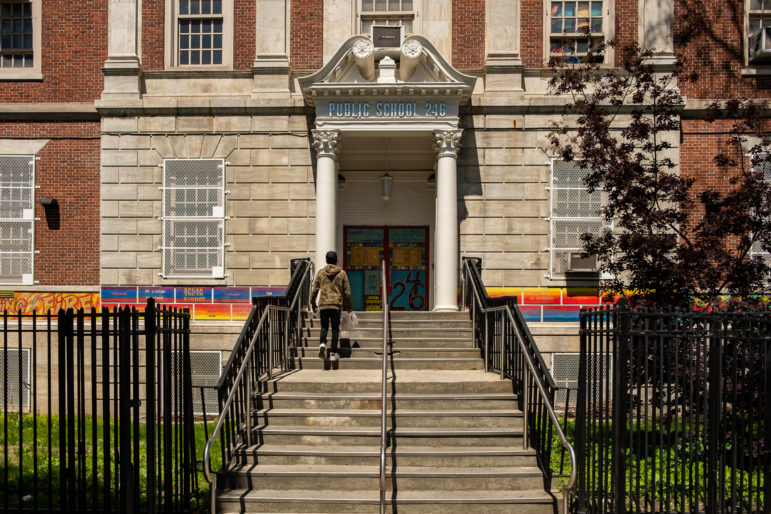“Democracies cannot function when entire groups of people are insulated from the realities of those they don’t understand. By reframing the issue as an urgent threat to democracy, we may become more motivated to change.”

Adi Talwar
A student heads to school in The Bronx.Self-regulated echo-chambers have negatively impacted public discourse in every field, and thoughtful debate on public education has been no exception. Nowhere is that more clear than in our inability to form consensus on one of the most long-standing tensions since Brown v. Board of Education: whether or not racial integration in schools is a worthwhile, realistic goal. Although it is admittedly a polarizing issue and solutions are complex, prioritizing school integration is more than a moral imperative—the fate of our multiracial democracy is at stake.
To some, it may seem incomprehensible to imagine this concept being up for debate at all. Study after study has pointed to the increased academic, cognitive, civic and socio-emotional benefits of a diverse learning environment at every level of schooling. For decades, the Supreme Court has recognized the use of race as a factor in higher education admission policies as a compelling government interest (although sadly, that may soon change with a conservative supermajority set to overturn precedent). Even in strictly economic terms, school integration has been proven to boost student achievement and better prepare students for work in a diverse global economy.
Generational struggles to integrate K-12 schools, and the resulting scars for those who have borne the brunt of opposition for 60 years since Brown, have led to two overlapping but distinct schools of thought, both of which have de-prioritized integration. While the vast majority of people of color (and Black folks in particular) support integrated schools, there are a portion of folks who’ve only experienced integration efforts that unduly burden Black and brown communities. The paradigm of facilitating a pipeline of students from “bad” to “good” schools has impacted the students being transferred, and their teachers who were left behind. For some, it has contributed to a perspective that emphasizes improving schooling in under-resourced areas while leaving current patterns of segregation intact.
Others disagree with the premise that integrated classrooms derive any tangible benefit. Many folks who oppose or are indifferent to integration have little to no personal experience within integrated educational settings. In turn, they’ve been shielded from an understanding that education equates to more than textbook learning and fail to see the lifelong benefits of sociocultural competence.
Just weeks ago, during oral arguments on two affirmative actions cases, Justice Clarence Thomas commented, “I’ve heard the word diversity quite a few times and I don’t have a clue what it means.” He went on to say that when parents send their kids to college “they don’t necessarily send them there to have fun or feel good or anything like that. They send them there to learn physics or chemistry or whatever they’re studying.” His attitudes reflect the cynical justifications of communities sheltered (either by choice or systemic factors) from the possibilities of American multicultural pluralism.
Similar lines of thought pervade large swathes of white and east Asian communities in K-12 education, even in self-proclaimed “progressive” areas. My own experience as a biracial Asian and white student in wealthy self-segregated schools mirrored this dynamic. My classmates and I became prototypically “successful” students, but were never given the opportunity to benefit from learning across major lines of difference.
For those who believe integration should no longer be a priority, or those who follow the misguided belief that integration serves no purpose at all, one thing is true—shrugging our shoulders or directly opposing the goal of educational diversity is a threat to our country’s democracy.
When we fail to integrate our young people, we reap the consequences of a society already splintering at its seams. By the time students reach adulthood, those who have formed relationships across lines of difference, versus those who only encounter more homogenous groups throughout their educational careers, develop vastly different ideologies around the role racism plays in society, and the importance and urgency in rooting it out. As social media continues to filter us into increasingly polarized bubbles, homogenous schooling further encourages students to develop drastically divergent, isolated worldviews. Those worldviews cannot be equated—one group of predominantly people of color will continue to advocate for their basic civil rights into adulthood, while the other, disproportionately white folks, following in the footsteps of their self-segregated white communities, will continue to ignore or downplay the experiences of marginalized folks in their communities, in the workforce, and in the voting booth.
A sense of empathy for others may be the defining feature in whether the political experiment of American democracy will persist. While a lack thereof has dominated much of our current political and social reality, from the rise in hate crimes to racial anxiety-fueled Trumpism to the increased support of election denialism, we should connect the dots between how young people learn and how our society is formed. Democracies cannot function when entire groups of people are insulated from the realities of those they don’t understand. By reframing the issue as an urgent threat to democracy, we may become more motivated to change.
While hearts and minds won’t change overnight, everyday folks can follow the lead of those who have experienced painful efforts of the past, and commit to action on integrating education. Whether it’s demanding local school leaders develop enrollment policies with concrete commitments to diversity, supporting legislation mandating reporting on measures of racial and socioeconomic integration to re-frame how we define “good” schools by taking integration into account, or by white parents enrolling children in schools where they are not the racial majority, we have the opportunity to prioritize an issue that will yield both improved learning for students and help rescue our fading democracy.
Jeremy Chan-Kraushar works on racial equity initiatives in public education in New York City. He has a M.Ed, a MPA, and a JD.








